Frothed milk is a popular addition to many coffee and tea drinks. It adds a creamy texture and a touch of elegance to your favorite beverage. While there are many ways to froth milk, one question often arises is whether you can froth milk in a blender.
Can you froth milk in a blender?
The answer is yes. You can froth milk in a blender, which can be a quick and easy way to achieve the perfect froth. Blenders are commonly used to make smoothies but can also be used for froth milk.
The process is simple and requires only a few basic steps. However, it’s essential to use the right type of blender and follow the correct technique to achieve the desired results.

Blender vs. Frother
Is a milk frother the same as a blender?
Regarding frothing milk, a milk frother and a blender are two different appliances. A milk frother is designed to create a creamy, frothy texture by introducing air into the milk. On the other hand, a blender is a more versatile appliance that can be used for various tasks, including blending, pureeing, and crushing ice.
How a Blender Works
A blender uses a powerful motor to spin a set of blades at high speeds. The blades chop and blend the ingredients, creating a smooth and consistent texture.
When it comes to frothing milk, a blender can be used, but it is not the ideal appliance.
The high-speed blades of a blender can create a lot of foam, but the texture is not as smooth and creamy as that produced by a milk frother.
How a Frother Works
A milk frother uses a small motor to spin a whisk or paddle inside a milk container. As the whisk or paddle spins, it introduces air into the milk, creating a frothy and creamy texture.
Milk frothers come in various styles, including handheld, electric, and stovetop frothers.
Each type of frother has advantages and disadvantages, but all are designed to produce a smooth and creamy texture perfect for lattes, cappuccinos, and other coffee drinks.
Is French Press Coffee Stronger Than Drip? A Fact-Based Comparison
Frothing Milk in a Blender
Step-by-Step Guide
Frothing milk in a blender is a quick and easy way to create creamy, frothy milk for your favorite coffee drinks. Here is a step-by-step guide to frothing milk in a blender:
- Heat the milk: Pour it into a microwave-safe container and heat it for 30-45 seconds until it’s warm but not boiling. Alternatively, you can heat the milk on the stove.
- Blend the milk: Pour the warm milk into the blender and blend on high for 15-20 seconds until it becomes frothy and creamy.
- Using an immersion blender, use a half cup of milk in a deep container. Start with a slow speed for 10 seconds and then increase the speed. Or the milk will spill everywhere.
- Serve: Pour the frothed milk into your coffee or espresso and enjoy.
Tips for Best Results
Here are some tips to help you achieve the best results when frothing milk in a blender:
- Use a blender with a high-speed setting: A high-speed blender will create more froth and give you better results.
- Use whole milk: Whole milk creates the best froth due to its higher fat content.
- Use warm milk: Cold milk will not froth as well as warm milk, so be sure to heat the milk before blending.
- Experiment with different milk types: You can also try frothing almond milk, soy milk, or other non-dairy milk alternatives.
- Clean the blender thoroughly: After you’re done frothing the milk, clean the blender thoroughly to avoid any milk residue buildup.
Following these simple steps and tips, you can easily freeze milk in a blender and create creamy, frothy milk for your coffee drinks.
How Long Does It Take to Froth Milk in a Blender?
When it comes to frothing milk in a blender, the time it takes to achieve the desired frothiness can vary depending on a few factors. Factors such as the type of blender, the amount of milk being frothed, and the desired level of frothiness can all impact the time it takes to froth milk in a blender.
Generally, froth milk in a blender can take 15 seconds to a few minutes.
Keep a close eye on the milk while it’s being frothed, and stop the blending process once the desired level of frothiness is achieved.
One factor that can impact the time it takes to froth milk in a blender is the type used. High-speed blenders may be able to froth milk more quickly than lower-speed blenders.
Additionally, the amount of milk being frothed can impact the time it takes to achieve the desired level of frothiness. Frothing a small amount of milk may take less time than frothing a larger amount.
Another factor to consider is the desired level of frothiness. If a light froth is desired, it may take less time than a thick, creamy froth.
How do you know when milk is frothed?
When frothing milk in a blender, it can be challenging to know when the milk is perfectly frothed. However, a few indicators to look out for can help determine when the milk is ready.
Firstly, the milk will increase in volume as it froths. This is because the blender will introduce air into the milk, creating a frothy texture. As the volume increases, the milk will become lighter and more aerated.
Another way to determine when the milk is frothed is by looking at the texture. Frothed milk should have a creamy, velvety texture and small bubbles throughout. The milk may not be frothed enough if it has large bubbles or a thin, watery texture.
The sound of the blender can also indicate when the milk is frothed. As the milk froths, the blender will make a distinct sound, changing as the milk becomes more aerated. When the sound becomes higher in pitch and more consistent, it indicates that the milk is perfectly frothed.

Conclusion
In conclusion, frothing milk in a blender is possible but not the most efficient method. While a blender can produce a decent froth, it is not as consistent as using a milk frother or steam wand.
One of the main issues with using a blender is that it can create too much foam, making it difficult to pour the milk properly. The blender can also heat the milk unevenly, resulting in a less-than-perfect froth.
However, a blender can be a viable alternative if a milk frother or steam wand is unavailable. It is essential to use the proper technique and monitor the milk closely to prevent over-frothing.
Overall, while frothing milk in a blender may not produce the same quality of froth as other methods, it can still be a practical option in a pinch.
How to use coffee pods without the machine?
Does cinnamon dissolve in coffee? How to add cinnamon to coffee?
How to prepare ground coffee at home?